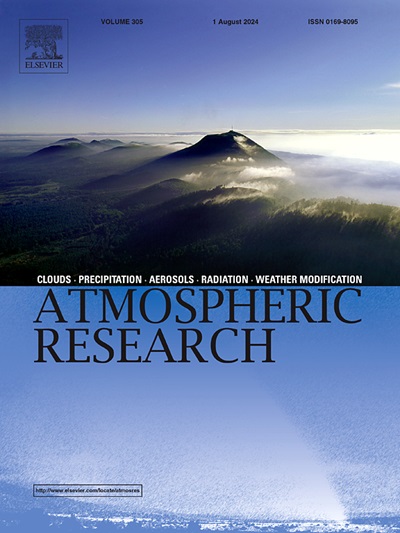Outer-core size asymmetry and intensification of North Atlantic tropical cyclones
IF 4.5
2区 地球科学
Q1 METEOROLOGY & ATMOSPHERIC SCIENCES
引用次数: 0
Abstract
Challenges persist in accurately predicting tropical cyclone (TC) intensification and intensity change, owing to restricted understanding of the mechanisms involved. Here the relationship between TC asymmetry (TCA) of outer-core wind field and intensification over the North Atlantic is investigated using best-track and satellite-based wind analysis data from 2000 to 2021. The results suggest a negative correlation between TCA and the upper limit of intensification rate (IR), except in nearly symmetric TCs. TC records are categorized into groups of low, medium, and high asymmetry based on the distribution of TCA. The 24-h evolution of TCA and its variation preceding intensification onset reveal significant differences between TCs with low-to-medium and high asymmetry. TCs with low-to-medium asymmetry tend to exhibit axisymmetrization of the wind field under smaller vertical wind shear (VWS). In contrast, highly asymmetric TCs display sharp increases in wind speed on the downshear-left side of greater-magnitude VWS vector, which can reduce vortex tilt and fortifies TC's resilience against VWS. Furthermore, TCs with higher TCA encounter greater challenges during their intensification stage, especially those with lower lifetime maximum intensity (LMI). TCA reflects the worsening disorganization of convection or the expansion of the inner-core wind field, rendering weaker TCs more susceptible to the effects of VWS. These findings underscore the nuanced relationship between TCA and TC intensification, demonstrating that TCA can serve as an additional indicator to improve the accuracy of TC intensity predictions, while also providing novel insights into the mechanisms driving TC intensification.
北大西洋热带气旋外核大小不对称与增强
由于对所涉及的机制了解有限,在准确预测热带气旋(TC)增强和强度变化方面仍然存在挑战。本文利用2000 - 2021年的最佳跟踪和卫星风分析数据,研究了北大西洋外核风场的TC不对称(TCA)与强度之间的关系。结果表明,除了近对称tc外,TCA与强化率上限(IR)呈负相关。根据TCA的分布,将TC记录分为低、中、高不对称组。TCA的24小时演变及其在强化开始前的变化在低-中等和高度不对称的TCA之间存在显著差异。在较小的垂直风切变(VWS)条件下,中低不对称的风场趋于轴对称。相反,高度不对称的TC在更大量级的VWS矢量的下切面左侧风速急剧增加,这可以减少涡倾斜,增强TC对VWS的恢复能力。此外,TCA较高的TCs在其强化阶段面临更大的挑战,特别是那些寿命最大强度(LMI)较低的TCs。TCA反映了对流无序性的恶化或内核风场的扩大,较弱的TCs更容易受到VWS的影响。这些发现强调了TCA与TC增强之间的微妙关系,表明TCA可以作为提高TC强度预测准确性的额外指标,同时也为驱动TC增强的机制提供了新的见解。
本文章由计算机程序翻译,如有差异,请以英文原文为准。
求助全文
约1分钟内获得全文
求助全文
来源期刊

Atmospheric Research
地学-气象与大气科学
CiteScore
9.40
自引率
10.90%
发文量
460
审稿时长
47 days
期刊介绍:
The journal publishes scientific papers (research papers, review articles, letters and notes) dealing with the part of the atmosphere where meteorological events occur. Attention is given to all processes extending from the earth surface to the tropopause, but special emphasis continues to be devoted to the physics of clouds, mesoscale meteorology and air pollution, i.e. atmospheric aerosols; microphysical processes; cloud dynamics and thermodynamics; numerical simulation, climatology, climate change and weather modification.
 求助内容:
求助内容: 应助结果提醒方式:
应助结果提醒方式:


